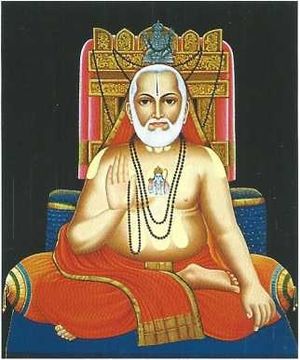Raghavendratirtha
By Swami Harshananda
Raghavendratirtha lived in A. D. 1595-1671. He was one of the brightest stars of Dvaita Vedānta philosophy after Madhvācārya who lived in A. D. 1238-1317. He was popularly known as ‘Rāyaru’ in Karnataka. He was born to Viṇā Timmaṇṇabhaṭṭa and Gopamma as their last child by the special grace of Lord Veñkaṭeśvara of Tirupati. He was named as Veñkatabhatta. Being extraordinarily intelligent, he mastered the scriptures at an early age. He also became proficient in playing Vīṇā.[1]
He was married to Sarasvatīdevī and had a son named Lakṣmīnārāyaṇa. Later on, Suddhindratīrtha,[2] the pontiff of a Mādhva maṭha[3] under whom Veṅkaṭabhaṭṭa had got higher education and gave him sanyāsa[4] and appointed him as his successor. His monastic name was Rāghavendratīrtha.
During his long tenure as the next pontiff[5] he contributed a lot to the spread of Dvaita Vedānta through his scholarly compositions, disputations and discourses. He had unique yogic powers which he liberally used to uplift those that badly needed succor.
In A. D. 1671, at the age of 76, he sat in deep meditation inside the Bṛndāvana he had specially got prepared. It was filled up over his living body. He is believed to be still alive there, in his subtle body. Bṛndāvana is situated in the village then known as Mañcāle, and now as Mantrālaya. His devotees claim about the miracles happening till this date due to his presence and powers.
He had written 48 works in total. Some of his renowned works are:
- Nyāyasudhāparimalā
- Bhagavadgitā-vivrti
- Upanisatkhandārtha
- Rāmacaritra-mañjari
- Krsnacaritramañjari
References[edit]
- The Concise Encyclopedia of Hinduism, Swami Harshananda, Ram Krishna Math, Bangalore

